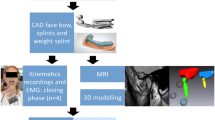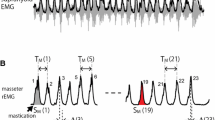Summary
The unloading reflex in the jaw closing muscles in man was investigated with a view to correlating the jaw closing movement with the timing of the electrical activity of the agonist and antagonist muscles. When the resistance to a forceful isometric bite was suddenly and unexpectedly withdrawn, the closing movement of the mandible was always arrested before the teeth came together. The rapid arrest of the jaw closing movement was not adequately accounted for by the timing of the inhibition of the jaw closing muscles and reflex excitation of the jaw opening muscles. It was observed that the jaw opening muscles, as well as the jaw closing muscles, were always active during the phase of isometric biting on an object between the teeth. It is therefore concluded that the resulting stiffness of the antagonist muscles is the mechanism which is principally responsible for limiting the jaw closing movement after unloading of the agonist muscles.
Similar content being viewed by others
References
Angel RW, Eppler W, Iannone A (1965) Silent period produced by unloading of muscle during voluntary contraction. J Physiol (Lond) 180: 864–870
Angel RW, Garland H, Moore W (1973) Unloading reflex during blockade of antagonist muscle. EEG Clin Neurophysiol 34: 303–307
Cavagna GA, Dusman B, Margaria R (1968) Positive work done by a previously stretched muscle. J Appl Physiol 24: 21–32
Dmytruk RJ (1974) Neuromuscular spindles and depressor masticatory muscles of monkey. Am J Anat 141: 147–153
Grillner S (1972) The role of muscle stiffness in meeting the changing postural and locomotor requirements for force development by the ankle extensors. Acta Physiol Scand 86: 92–108
Hannam AG, Matthews B, Yemm R (1968) The unloading reflex in masticatory muscles of man. Arch Oral Biol 13: 361–364
Hansen K, Hoffman P (1922) Weitere Untersuchungen über die Bedeutung der Eigenreflexe für unsere Bewegungen. I. Anspannungs- und Entspannungsreflexe. Z Biol 75: 293–304
Hoffner JA, Andreassen S (1981) Regulation of soleus muscle stiffness in premammillary cats: Intrinsic and reflex components. J Neurophysiol 45: 267–285
Joyce GC, Rack PM, Westbury DR (1969) The mechanical properties of cat soleus muscle during controlled lengthening and shortening movements. J Physiol (Lond) 204: 461–474
Kubota K, Masegi T (1977) Muscle spindle supply to the human jaw muscles. J Dent Res 56: 901–909
Lamarre Y, Lund JP (1975) Load compensation in human masseter muscles. J Physiol (Lond) 253: 21–35
Luschei ES, Goodwin GM (1974) Patterns of mandibular movement and jaw muscle activity during mastication in the monkey. J Neurophysiol 37: 954–966
Melville Jones G, Watt DGD (1971) Observations on the control of stepping and hopping movements in man. J Physiol (Lond) 219: 709–727
Pruim GJ, ten Bosch JJ, de Jongh HJ (1978) Jaw muscle EMG- activity and static loading of the mandible. J Biomech 11: 389–395
Rack PMH, Westbury DR (1974) The short range stiffness of active mammalian muscle and its effect on mechanical properties. J Physiol (Lond) 240: 331–350
Westphal C (1880) Über eine Art paradoxer Muskelkontraktur. Arch Psychiat Nervenkrankh 8: 788–792
Author information
Authors and Affiliations
Additional information
Supported by the National Health and Medical Research Council of Australia, and the Australian Dental Education and Research Trust
Rights and permissions
About this article
Cite this article
Miles, T.S., Wilkinson, T.M. Limitation of jaw movement by antagonist muscle stiffness during unloading of human jaw closing muscles. Exp Brain Res 46, 305–310 (1982). https://doi.org/10.1007/BF00237189
Received:
Published:
Issue Date:
DOI: https://doi.org/10.1007/BF00237189




